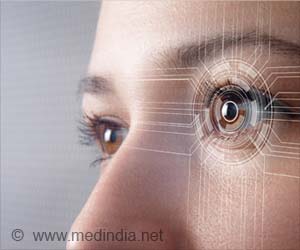The KIMM Department of Nano Manufacturing Technology’s Principal Researcher JaeJong Lee, Yonsei University Professor Won-gun Koh, and Severance Hospital Ophthalmology Professors Hyung Keun Lee and Professor Yong-woo Ji focused on the characteristics of the eye, which is directly connected to the brain, and detected various biomarkers through trilateral cooperation between the KIMM, Yonsei University, and Severance Hospital. They created an implantable biosensing system by mounting a bio-responsive hydrogel-based sensing module capable of detecting various biomarkers on an intraocular lens to express a signal in a moiré pattern, a pattern characterized by regularly repeating shapes that are continuously combined and
recombined, creating visual stripes based on differences in the overlapping shapes.
When the antibody-bound hydrogel pattern reacts with the target biomarker, it contracts. The target biomarker is then detected utilizing changes in the moiré signal caused by the hydrogel pattern narrowing due to the contraction response overlapping with the specified reference grid. Detection with a moiré signal is substantially more sensitive than other approaches that directly detect changes in the hydrogel pattern.
Advertisement
In addition, unlike standard biosensors, the moiré signal-based biomarker detection approach may detect biomarkers directly without the use of electrochemical or fluorescent labels. One advantage of this approach is that it can be implanted within the body because it does not require external power or a light source.
Can we Predict Alzheimer’s Disease Through the Eye Lens?
Alzheimer’s Disease (AD) is a common dementia problem in the elderly population. The two main hallmarks of AD are tau protein and amyloid beta protein. The relevant investigations on AD suggest that these proteins are also seen in the eye. There are many tests and imaging modalities used for AD diagnosis. But these techniques are still unable to predict the disease effectively. In this regard, the lens of the eye may help in diagnosing AD. Therefore, a reliable technique for measuring the lens or retina must be selected (2✔ ✔Trusted Source
Can we predict Alzheimer’s Disease through the eye lens?
Go to source
).
Reference :
- Real-time and label-free biosensing using moiré pattern generated by bioresponsive hydrogel – (https://www.sciencedirect.com/science/article/pii/S2452199X22004741)
- Can we predict Alzheimer’s Disease through the eye lens? – (https://www.heighpubs.org/hceo/ijceo-aid1031.php)
Source: Medindia



